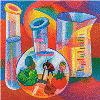Chemical and Biomolecular Engineering Research and Publications
Crossflow Microfiltration of Recombinant Escherichia coli Lysates after High Pressure Homogenization
Date of this Version
November 1997
Abstract
Abstract: Crossflow membrane filtration was used to process recombinant Escherichia coli cell lysates containing protein inclusion bodies after high pressure homogenization. The number of passes through the high pressure homogenizer changed the viscosities and average particle sizes of the cell lysates. The different cell lysates were processed with a hollow fiber unit containing microfiltration membranes and a plate and frame unit with either ultrafiltration or microfiltration membranes. There were differences in permeate flux and protein transmission for the various membranes with the best performing membranes giving permeate fluxes greater than 60 L m−2 h−1 and protein transmissions greater than 90%. For a given membrane, no differences were observed between the cell lysates following homogenization with one, two, and three passes at 83 MPa. The lack of a difference between the three lysates is due to their similarities with respect to the released macromolecules and the presence of small (<0.1 μm) cell debris.


Comments
Originally published in BIOTECHNOLOGY AND BIOENGINEERING, VOL. 56, NO. 3, NOVEMBER 5, 1997;John Wiley & Sons, Inc. This article is published as paper number 11601, the Journal Series of the Nebraska Agricultural Experiment Station, Lincoln, NE 68583-0704. PDF version of this article can be viewed at the Publishers site: http://www3.interscience.wiley.com/cgi-bin/fulltext/71004044/PDFSTART